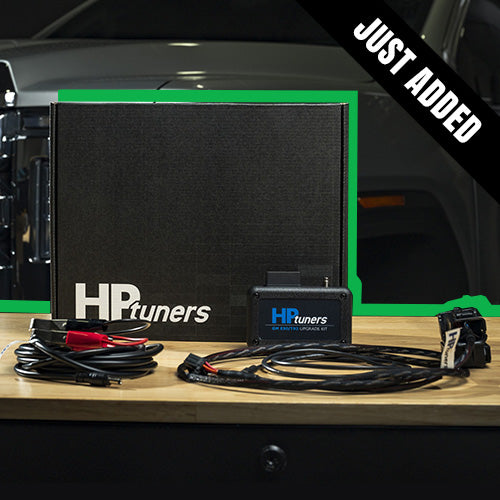

The Ultimate Guide to Ford 6.0L Powerstroke Up-Pipes (2003–2007)
What Are Up-Pipes?
On a 6.0L Powerstroke, the up-pipes are part of the exhaust system that channel hot exhaust gases from each exhaust manifold into the turbocharger’s turbine housing. They’re a critical link in making boost — without solid, leak-free up-pipes, your turbo can’t spool efficiently, EGTs (exhaust gas temperatures) rise, and power drops off.
The 6.0L design uses a two-pipe system:
- Driver Side Up-Pipe: Runs from the driver-side exhaust manifold to the turbo inlet collector.
- Passenger Side Up-Pipe: Runs from the passenger-side exhaust manifold to the turbo inlet collector.
The turbo inlet collector then directs the combined exhaust flow into the turbocharger. Many up-pipes also incorporate EGR connectors (depending on model year) for the factory exhaust gas recirculation system.

Why Would You Replace Your Up-Pipes?
While they may seem simple, factory 6.0L up-pipes have a notorious weak point: the flex bellows. This corrugated section is designed to absorb movement from engine torque and vibration. Over time, it can develop cracks, leaks, and pinholes — especially on tuned trucks, heavy towing applications, or high-mileage daily drivers.
Here are the top reasons to replace them:
| Reason | Symptoms | Impact if Ignored |
|---|---|---|
| Cracked or leaking bellows | Ticking or hissing sound, soot buildup, exhaust smell in cab | Reduced turbo boost, lower power, higher EGTs, potential turbo damage |
| Failed EGR connection | Check engine light, failed emissions test | Poor performance, increased NOx emissions |
| Corrosion / rust | Visible pitting or flaking on pipes | Structural failure risk, dangerous exhaust leaks |
| Performance upgrades | Higher flowing, stainless pipes | Better turbo response, durability under higher boost |
Common Issues & Known Problems on the 6.0L
- Bellows Failure: The stock double-layer bellow is prone to cracking, especially on tuned trucks. Heat cycling weakens the material.
- Exhaust Leaks at Collector Flanges: Warped flanges or worn gaskets allow exhaust to escape before hitting the turbo.
- EGR Tube Cracks: On early 2003–2004.5 trucks, the EGR connector on the up-pipe can split under heat and pressure.
- Bolt Seizure: The bolts that connect the up-pipes to the turbo collector and manifolds often seize due to heat, requiring penetrating oil, heat, or cutting during removal.
Benefits of Upgrading to Aftermarket or OEM-Plus Replacements
Aftermarket brands like PPE and BD Diesel redesign the weak points:
- Stainless Steel Construction: Resists rust and corrosion far better than OEM mild steel.
- Improved Bellows Design: Multi-layer, high-grade stainless bellows handle higher EGTs and boost without cracking.
- Thicker Flanges: Reduce warping under thermal load for longer gasket life.
- Direct-Fit Design: Matches OEM routing, bolt patterns, and EGR connections for easy installation.

Product Spotlight: Your Options
| Part Number | Model Years | EGR Compatible | Material | Price |
|---|---|---|---|---|
| PPE 316119504 | 2004–2007 F250/F350 6.0L | Yes | Stainless Steel | $269.99 |
| PPE 316119503 | 2003.5–2004 F250/F350 6.0L | Yes | Stainless Steel | $269.99 |
| BD Diesel 1043917 | 2003–2004.5 F250/F350 6.0L | Yes | T304 Stainless | $424.95 |
| BD Diesel 1043918 | 2004.5–2007 F250/F350 6.0L | Yes | T304 Stainless | $424.95 |
Basic Installation Overview
Skill Level: Intermediate (some experience with turbo removal is helpful)
Tools Needed:
- 10mm, 12mm, and 15mm sockets
- Penetrating oil
- Pry bars and extensions
- Torque wrench
- Safety glasses and gloves
Steps:
- Disconnect Batteries – Safety first.
- Remove Turbocharger – Unbolt from pedestal, disconnect oil feed/drain, compressor/turbine connections.
- Soak Up-Pipe Bolts – Use penetrating oil on manifold and collector bolts. Let sit.
- Remove Old Up-Pipes – Expect seized bolts; a torch or bolt extractor may be needed.
- Clean Surfaces – Remove old gaskets and carbon buildup.
- Install New Up-Pipes – Position with new gaskets, torque bolts evenly.
- Reinstall Turbocharger – Reconnect oil lines, intake, and exhaust connections.
- Start & Check for Leaks – Listen for hissing, inspect for soot marks.
Tips for Long-Term Reliability
- Always use new OEM-quality gaskets.
- Avoid over-tightening — warped flanges leak.
- Inspect up-pipes during any turbo service.
- Consider ceramic coating for heat management.

Final Word
The 6.0L Powerstroke is infamous for certain weaknesses, but the up-pipes don’t have to be one of them. Replacing failing stock units with upgraded PPE or BD Diesel up-pipes ensures your turbocharger sees all the exhaust energy it needs for maximum boost and efficiency. Whether you’re restoring a daily driver or prepping a tow rig for heavy hauling, investing in quality up-pipes pays back in power, reliability, and peace of mind.
Frequently Asked Questions
Will replacing my up-pipes increase horsepower?
Yes — if your current pipes are leaking, sealing the system can restore lost boost and power. Gains are from regaining lost efficiency, not from adding more flow than stock.
Do I have to remove the turbo to replace up-pipes?
On a 6.0L, yes. Turbo removal is required to access the collector bolts and properly install the new pipes.
Are aftermarket up-pipes emissions-legal?
All PPE and BD Diesel EGR-compatible models for the 6.0L retain factory emissions equipment. Always verify local and state laws before installation.
Learn More
Was this article helpful? Pass it on
- Choosing a selection results in a full page refresh.
!












